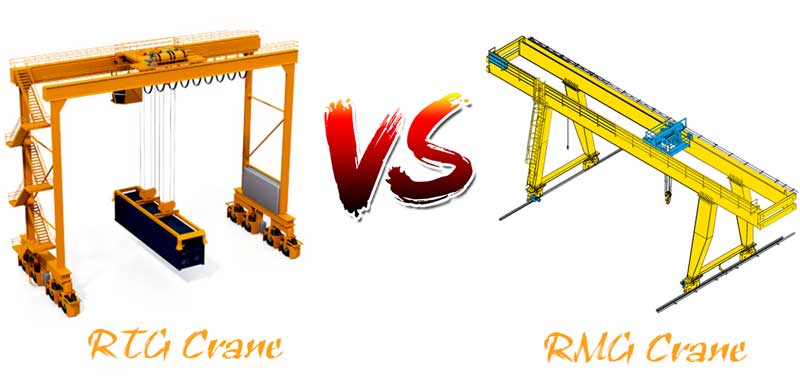What’s the Difference between Rubber Tyred Gantry Crane and Rail Mounted Gantry Crane?
With the rapid development of world container transportation, short supply cycle, rubber tyred gantry cranes (RTG crane) and rail mounted gantry cranes (RMG crane) have been widely used in the container yard, High quality RTG crane and RMG crane are increasingly being demanded by users. but there are still some problems on rubber tyred gantry crane and rail mounted gantry crane. The functions of the two cranes are similar, but there are some differences in technical performance, loading and unloading performance, operation performance, economic performance, automation performance and so on.

Comparison between rubber tyred gantry crane and rail mounted gantry crane
Loading and unloading performance
Loading and unloading coverage
Suppose the container handling yard area of the wharf is 40,000 ㎡,the following two loading and unloading processes can be chosen.
RTG Crane: We can arrange six container handling yards whose length is 156m and width is 23.47m, equipped with 5-6 rubber tyred gantry cranes, divide it into five areas, each area has 24 columns and 6 rows, a total of 720 containers can be stored.
RMG Crane: We can arrange two container handling yards whose length is 170m and width is 47m, equipped with 4 rail mounted gantry cranes, divide it into two areas, each area has 26 columns and 16 rows, a total of 832 containers can be stored. The tractor channel of container is under the extend cantilever outside the RMG rail.
Loading and unloading efficiency
- Technical parameters. Due to the limitation of engine generator system, the hoisting speed of RTG should not be too fast, otherwise it may cause the engine of rubber tyred gantry crane stalling or speeding. However, RMG directly uses the power of the electric network system, it has better mechanical characteristics in starting, braking and heavy load lifting and falling, When the distance of run is large, the hoisting mechanism, the trolley mechanism and the cart mechanism can run rapidly.
- Maneuverability. RTG can conduct 90 degree turn, so as to realize operated in other field, however, the friction between the tire and the ground on both sides of the running bridge is very different, so it is easy to deviate, it must be rectified constantly, otherwise safety accidents are easy to happen. Although RMG can only walk along the fixed track, it can not realize the transfer field operation, but it doesn’t need to rectify a deviation.
- Breakdown downtime. Rubber tyred gantry crane adopts engine generator system and steering hydraulic system, the drive and control lines are driven from the electrical room to the cab via the towing cable, mechanical failures are more, downtime is longer, and the maintenance is more difficult. In contrast, RMG is more reliable and more convenient to maintain.
Operation performance
There are many exhaust gases and noise in RTG, which seriously disturbs the communication between the crane operator and the ground personnel, weakens the warning effect of the cart walking alarm, easily leads to safety accidents. RMG does not emit waste gas, and no noise, the whole machine running quiet and smooth, the crane driver and the ground staff can community unobstructed.
Technical performance
As shown in the table, in addition to the car walking and transfer flexibility is better than RMG, other aspects of RTG are inferior to RMG or no obvious advantage.
| Main Parameter | RTG | RMG | Differences | |
|---|---|---|---|---|
| RTG | RMG | |||
| Rated Lifting Weight (t) | 40.5 | 40.5 | ||
| Span (m) | 23.47 | 47 | The span is small and single, no extend cantilever | |
| Rated Lifting Height (m) | 18.2 | 18.2 | ||
| Base Distance (m) | 6.4 | 16 |
Smaller |
Bigger |
| Full Load Lifting Speed (m/min) | 20 | 30 | ||
| No Load Lifting Speed (m/min) | 40 | 50 | ||
| Trolley Speed (m/min) | 70 | 120 | Slower |
Faster |
| Trolley Speed (m/min) | 90-135 | 80 |
Faster |
Slower |
| Driving Mode |
Diesel Engine Electric Motor |
AC Electric Motor |
||
| Running Bridge | Vacuum Tire | Steel Tyre | It can turn direction, but tires are easy to wear. | Walk on the track, unable to change direction. |
Automation performance
Rail mounted gantry crane runs along the fixed track, so the running bridge is not easy to run off, It is easy to realize automatic positioning and automatic control, so as to create necessary conditions for fully automated operation of container terminals. In contrast, RTG is difficult to achieve fully automated operations.
Economic performance
The average service life of rubber tyred gantry crane and rail mounted gantry crane are all about 25 years, the annual depreciation charge is mainly determined by the equipment purchase price, Because the purchase price is lower than the RMG RTG, the annual depreciation is a little lower than that of the latter.
Conclusion
Although the RTG occupies a large proportion in the domestic container yard machinery, but with the transformation of the mode of economic development, rising fuel prices and the requirements of environmental protection, the advantage of RTG is gradually weakening, shortcomings are becoming increasingly apparent, some ports are phasing out RTG or taking the "oil to electricity" approach to eliminate the disadvantages of rubber tyred gantry crane. By comparison, although rail mounted gantry crane started late in China, it has the advantages of high technical performance, high loading and unloading efficiency, low operation cost, high utilization rate of yard, convenient operation and maintenance, and easy to realize automation, moreover, the span and overhang distance of RMG can be customized to meet the requirements of different yard operations. Predictably, the rail mounted gantry crane will the place of rubber tyred gantry crane in the future, become the most vigorous loading and unloading machinery in container terminals.



